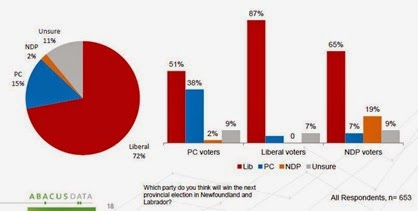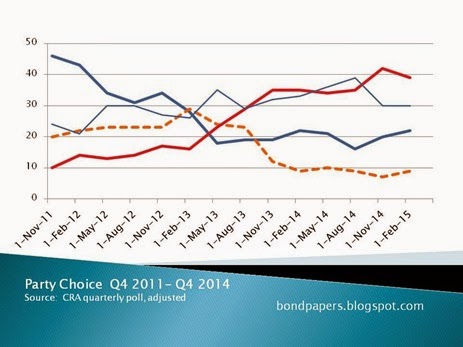[Updated: 1715 hrs]
By lunch time today, you’ll have Corporate Research Associate’s latest quarterly omnibus poll. Odds are the overall numbers on party choice for provincial politics will be in line with all the other polls we’ve seen over the last while.
What sets Abacus Data’s poll released on Tuesday is that Abacus asked a bunch of questions that give much greater insight into local public opinion than what you’ve seen from the other opinion research firms.
Before we get to that stuff, let’s look at the party choice numbers.
Here’s a comparison of the Abacus numbers, the past two CRA polls, and the MQO (share of all respondents):
| Abacus | ||||
| Liberal | 45 | 42 | 39 | 42 |
| Conservative | 26 | 20 | 22 | 20 |
| NDP | 07 | 07 | 09 | 07 |
| Und | 21 | 30 | 30 | 28 |
Before the Conservatives out there get all excited over that supposed jump for their team, understand that the difference between Abacus and the others is basically within the margin of error of the polls involved.
What they should look at instead is one of those insightful questions the Abacus people asked, namely, who respondents expect to win the next election. This has become a popular question since research suggested that the question was a reliable predictor of who will actually win the election.
Liberal = 72%.
Fifty-one percent of self-identified Conservative voters expect the Liberals to win.
Sixty-five percent of self-identified New Democrat voters expect the Liberals to win the next election.
If the research holds true, the Liberal share of the votes cast will be closer to 72% than any of the numbers polling firms come up with when they show you party choice as a share of “decided” or “committed” voters.
The other provincial poll results are more confirmation than anything else. Slide 16 shows the percentage of voters who are committed firmly to each party and the percentage who would consider switching.
Look at the core vote, the folks who wouldn’t switch. Liberals have 30% while the Conservatives have 15%. The rest might consider switching. We don’t’ know what would make them switch - Abacus apparently didn’t ask - but frankly, that 72% from the other questions suggests that even the respondents themselves weren’t really likely to change.
Add to that the question asking whether people would consider voting for another party. Here’s what Abacus said about the Conservative result:
For the incumbent PCs, they not only trail the Liberals in vote intention, but they have a much smaller pool of potential supporters than the Official Opposition and that pool is shrinking. Four in ten eligible voters said they would consider voting PC while 48% said they would not consider voting PC. That is an eleven point decrease from August 2014. The PC Party’s conversion rate is 59% indicating that there is still an opportunity for the party to convert potential supporters into actual supporters.
Forget the satisfaction numbers. Now you know why. Abacus found that among “committed voters who think NL is heading in the right direction (39%), 46% would vote PC and 46% would vote Liberal.” What’s more, a “majority of those who believe the government’s performance has been somewhere in between say they will vote Liberal.”
Asked whether the province is on the right track, 39% aid it was headed in the right direction, 40% said the wrong direction and 21% didn’t know.
Only 14% of respondents thought the current government was doing a good job and deserved re-election.
14%.
Thirty-nine percent wanted to vote them out of office, while 43% were in between.
None of this is good for provincial Conservatives.
Only 51% of respondents supported the government’s fight with Ottawa over CETA. Slightly more like the idea of cuts to the House of Assembly. Unfortunately for the Conservatives, neither of these issues was on the list of big issues for the respondents to the poll.
It gets worse for the Conservatives. Of the three big issues for voters – the deficit, health care, and the economy – a plurality of voters think the Liberals can do a better job of handling them than the Conservatives. The Conservatives are around 21% on health care and the economy and 25% on the deficit.
The New Democrats don’t even break out of single digits. They are irrelevant to the overwhelming majority of voters.
For the Liberals, they need to be careful of those weak endorsements on specific issues. Together with the number who want to vote the Conservatives out, it suggests that voters aren’t highly motivated or maybe not even strongly attached to the Liberals. That might be a sign the turn-out in the next election will be small. Or worse, it might be a sign that after the election, voters will easily turn on the Liberals.
Read the Abacus poll report before you hear anything from CRA later this morning. Whatever the CRA numbers are, you’ll likely be able to understand what they tell you – and what they don’t – by taking advantage of the Abacus poll data.
-srbp-
So not an Uptick Update:
CBC tweeted that the latest CBC poll shows the first uptick for the Conservatives since last summer. The headline on their online story also mentions the slight improvement in the Conservative position.
It’s two percentage points, folks, on a poll with a margin of error of 4.1% for that question. The total movement here is only half the margin of error, at best. It might be an uptick. It’s more likely nothing more than the minor variation from poll to poll.
If you look at the last eight quarters, back to May 2013, you will see the Conservatives have averaged about 20 percent since then. The one quarter with 16 percent of respondents was likely an outlier.
Just to confirm that interpretation, we have two other polling firms with data over the past six months. They show basically no change in the position of the parties.
_____________________________
Notes to main post
* Released by CRA on 4 Mar 15
** Corrected figures.

